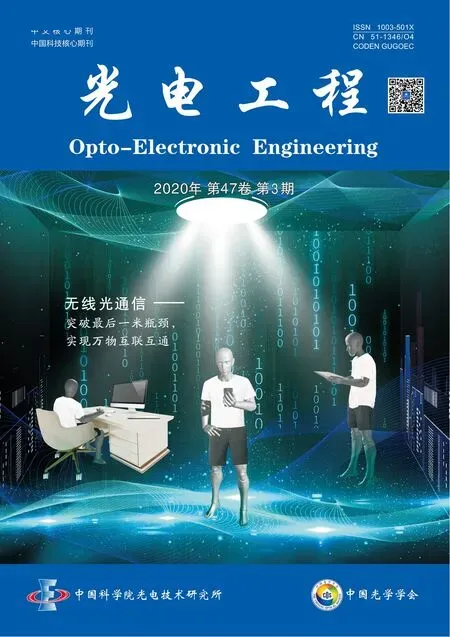云层厚度对蓝绿激光通信性能的影响分析
李松朗,毛忠阳,刘传辉,刘 敏
云层厚度对蓝绿激光通信性能的影响分析
李松朗*,毛忠阳,刘传辉,刘 敏
海军航空大学,山东 烟台 264001
针对机载激光发射器位于云层上方或云层中央时,云层的存在会降低激光通信性能的问题,仿真分析了不同类型的云层对激光能量衰减、信噪比、最大码元传输速率与误码率的影响。得到结论:云的存在主要造成激光能量衰减,影响最大传输速率与误码率,但对信噪比影响较小。链路余量大于18.9 dB的通信系统,链路上允许存在4 km的云层。云层对最大通信速率与误码率的影响主要是时间扩展造成码间串扰。卷云对通信性能几乎无影响;积云对通信性能的影响较大;层云、层积云和积雨云对通信性能的影响更大,但三种云的差异很小,可不作区分;高层云和雨层云对通信性能影响最大,其中雨层云的影响比高层云更大。
无线光通信;大气信道;光学厚度;云层厚度;蓝绿激光通信
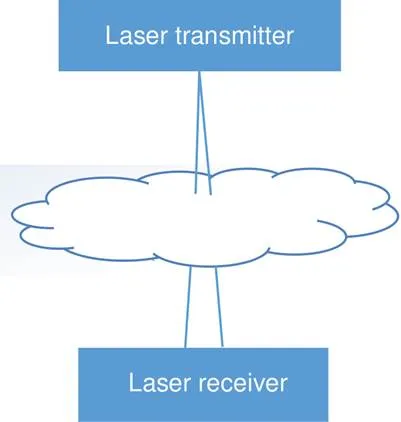
1 引 言
在机载蓝绿激光通信中,如果激光发射器位于云层上方或中央,云层会使激光能量衰减,导致通信质量下降,因此需要分析云层对蓝绿激光通信的影响,为改善方法的研究提供理论依据。
云对激光的衰减主要是米氏散射。在现有云层对蓝绿激光通信的分析中,Bucher和Mooradian通过实验给出了激光透过云之后的信号波形[1-2];狄凌峰等通过实验计算了532 nm激光在近地大气中的散射相位函数和气溶胶分布[3];Hess等通过理论公式计算了不同类型的云的衰减系数[4];胡秀寒等仿真分析了云高度和云厚度对激光到达海面的能量、角度分布、空间分布和时间分布的影响[5]。在现有云层对红外激光通信的分析中,Arnon等通过蒙特卡洛仿真给出了脉冲经过云层后的双Gamma拟合曲线和无码间串扰时的最大传输速率[6-7];刘建斌等计算了四种类型云的消光系数、单次散射返照率、不对称因子和散射相函数[8];陈纯毅等计算了红外波段激光通过云层后有码间串扰的误码率[9]。
上述文献在分析云层对通信性能的影响时仅在红外波段分析了云层厚度对误码率和最大传输速率的影响,但实际通信系统中造成误码的因素除了云层外,还有湍流的影响,并且蓝绿激光通信系统在传输距离和发散角与接收孔径方面均比红外通信系统大,因此不能直接参考红外波段的研究结论;在蓝绿波段仅从光学角度分析了能量的衰减与时间展宽,未对通信性能进行分析,也未对云层进行详细分类。
本文详细分析不同类型的云层及云层厚度对蓝绿激光通信的影响,并比较云层和湍流对通信影响的差异,为后续减小云层对通信影响的技术研究提供理论依据。
2 云衰减模型
云由于所处高度不同,按其微观粒子组成可分为水云、冰水混合云与冰云。积云、层云和层积云高度较低,属于水云;雨层云、积雨云和高层云云层较厚,属于冰水混合云;卷云高度较高,属于冰云。其中积云与卷云一般在晴天出现,而其他类型的云一般在阴天出现,他们的衰减系数如表1[6,10-12]。
云的光学厚度与物理厚度存在如下关系:

根据Vande Hulst公式,激光经过云层的能量透过率为[13]


3 云层厚度对链路能量衰减的影响
3.1 云层光学厚度与透过率
由于机载发射器距海平面最高为8 km,云的衰减系数最大为0.128 m-1,因此最大光学厚度为1024。仿真光学厚度0~1024的云层与相应的激光透过率,仿真结果如图1。
由图1知,光学厚度小于200时,激光能量衰减比较剧烈,之后能量衰减渐缓;云层为最大光学厚度1024时,对光的衰减约为19 dB。因此对于链路余量大于20 dB的通信系统,云层的存在不会使通信中断。
3.2 云层物理厚度与链路能量衰减
有云层时,通信系统的链路余量为

其中为无云时的链路余量。仿真不同类型的云及云层厚度对链路余量的影响,结果如图2。
由图2所示,卷云的透过率最大,云层厚度4 km时,激光通过-25 ℃卷云时能量减小了0.56 dB,-50 ℃卷云时能量减小了0.06 dB;层云、层积云和积雨云对能量衰减的趋势基本一致,4 km的云层厚度使能量减小了11.5 dB~11.8 dB;其次是积云,4 km的云层使能量减小了12.5 dB;雨层云和高层云对能量的衰减最大,云层厚度4 km时,雨层云使激光能量减小了16.18 dB,高层云使激光能量减小了15.45 dB。

表1 不同类型云的衰减系数
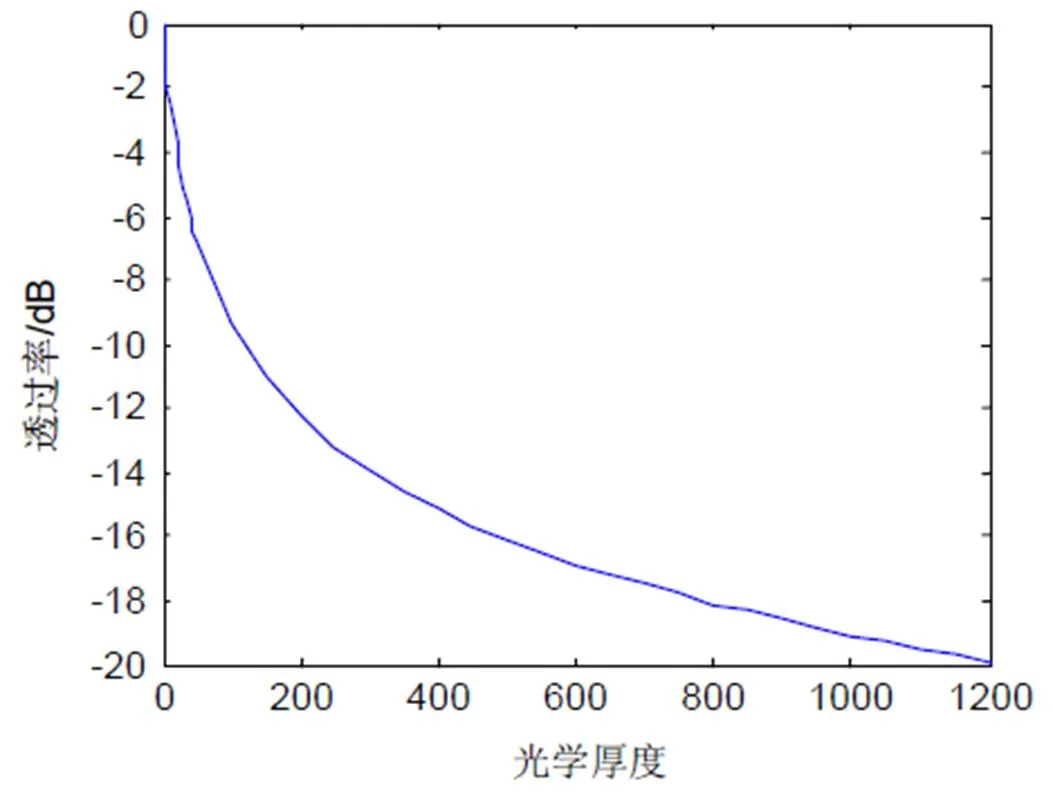
图1 光学厚度与透过率
值得注意的是,由于卷云与积云的水平面积小,呈现晴天,晴天云层下方气溶胶对激光的衰减比阴天时的小。根据文献[14],中纬度532 nm激光从距地8 km处向下发射,阴天时大气衰减比晴天多2.7 dB,在设计系统链路余量时需要考虑。因此,为使系统在链路上存在4 km的云层时也能正常接收信号,按能量衰减最为严重的雨层云计算,雨层云使激光能量减小了16.18 dB,由于出现雨层云时为阴天,阴天大气衰减又比晴天时多2.7 dB,则整体链路余量应大于18.88 dB。
4 云层厚度对信噪比的影响
不考虑云层厚度但考虑湍流强度时,通信系统的信噪比为[15]

考虑云层厚度与湍流强度时通信系统的信噪比为

在不考虑云层厚度和湍流强度的情况下,采用OOK调制时,信噪比为[16]

其中:为光电响应度,T为激光发射功率,为电子电荷,为探测器滤波带宽,atm为大气衰减,geo为几何衰减,其表达式为[15]

根据文献[14],中纬度532 nm激光从距地8 km处向下发射,晴天时大气衰减atm为74.58%,阴天为40.06%。

由图3与图4所示,云层厚度对信噪比的影响均较小,其中卷云厚度对信噪比无明显影响;积云次之;其次是层云、层积云和积雨云,不同湍流强度下信噪比均减小了不到0.03 dB;高层云和雨层云对信噪比的影响相对较大,云层厚度4 km时,高层云使中湍流信噪比减小了0.036 dB,弱湍流信噪比减小了0.061 dB;雨层云使中湍流信噪比减小了0.043 dB,弱湍流信噪比减小了0.073 dB。这也从侧面反应了随着湍流强度减弱,云层厚度对信噪比的影响逐渐增大,但云层对信噪比的影响远不如湍流对信噪比的影响,湍流的存在使信噪比从166 dB~309 dB骤降到5 dB~7 dB,云层的存在只使信噪比下降了不到0.1 dB,说明云层影响通信质量的方式不是降低信噪比,文献[8-9]指出,云层会使脉冲信号产生严重的时间展宽,从而造成高速率通信时的码间串扰。
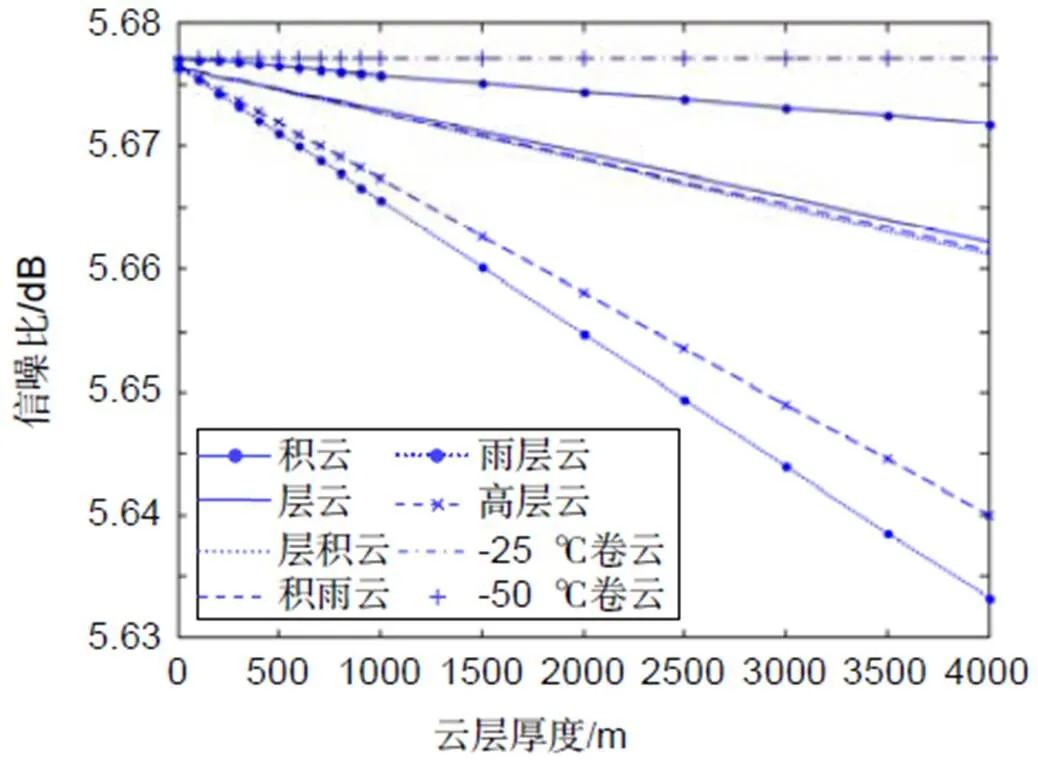
图3 中湍流云层厚度对信噪比的影响
5 云层厚度对最大传输速率的影响
文献[8-9]通过蒙特卡洛仿真得到了532 nm的激光脉冲通过五组不同光学厚度的薄云层时的波形,并拟合成双Gamma函数:

式中:1、2、3和4为双Gamma函数的常量系数,()为单位阶跃函数,参数拟合结果如表2。

表2 双Gamma函数的拟合结果
仿真曲线与拟合曲线如图5。
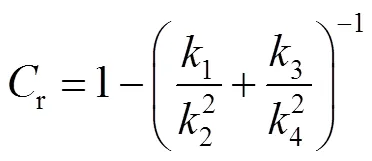

最大码元传输速率
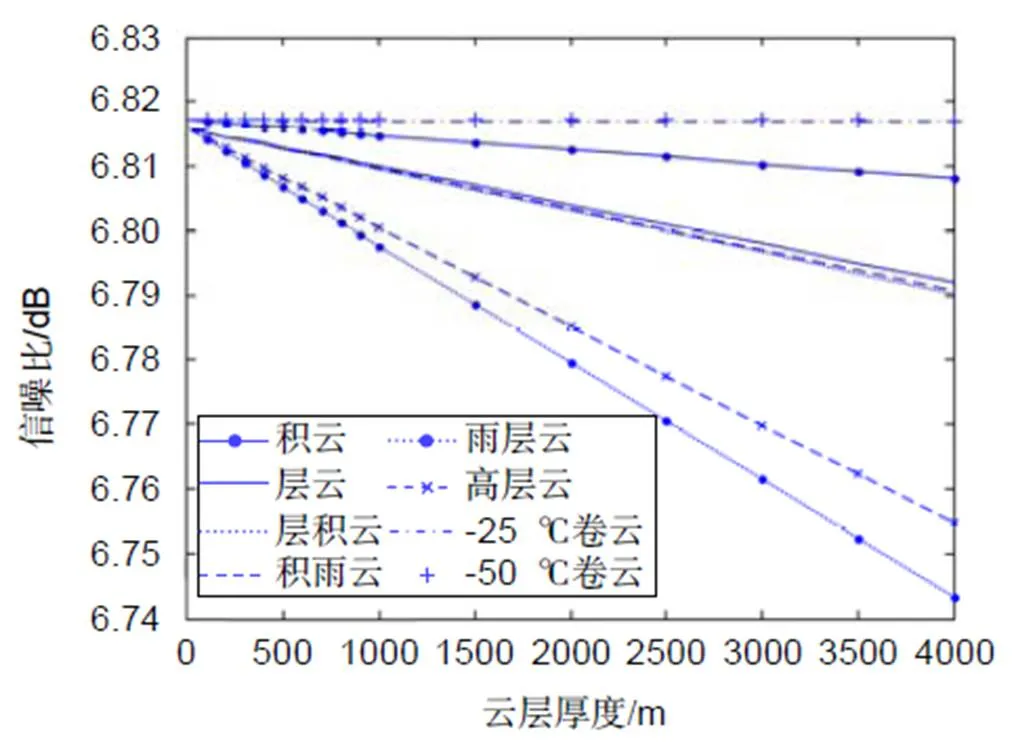
图4 弱湍流云层厚度对信噪比的影响


但云层的物理厚度较大时,上述公式不再适用,半功率点的时间扩展公式为[17]

云层厚度对最大传输速率影响较大,相同物理厚度时,卷云的最大传输速率最高,其次是积云、层云、层积云和积雨云,传输速率最小的为雨层云和高层云。云层厚度4 km时,雨层云与高层云的最大传输速率小于104bps,积云、层云、层积云和积雨云略大于104bps,-25 ℃卷云为2´105bps,-50 ℃卷云为1.3´106bps。
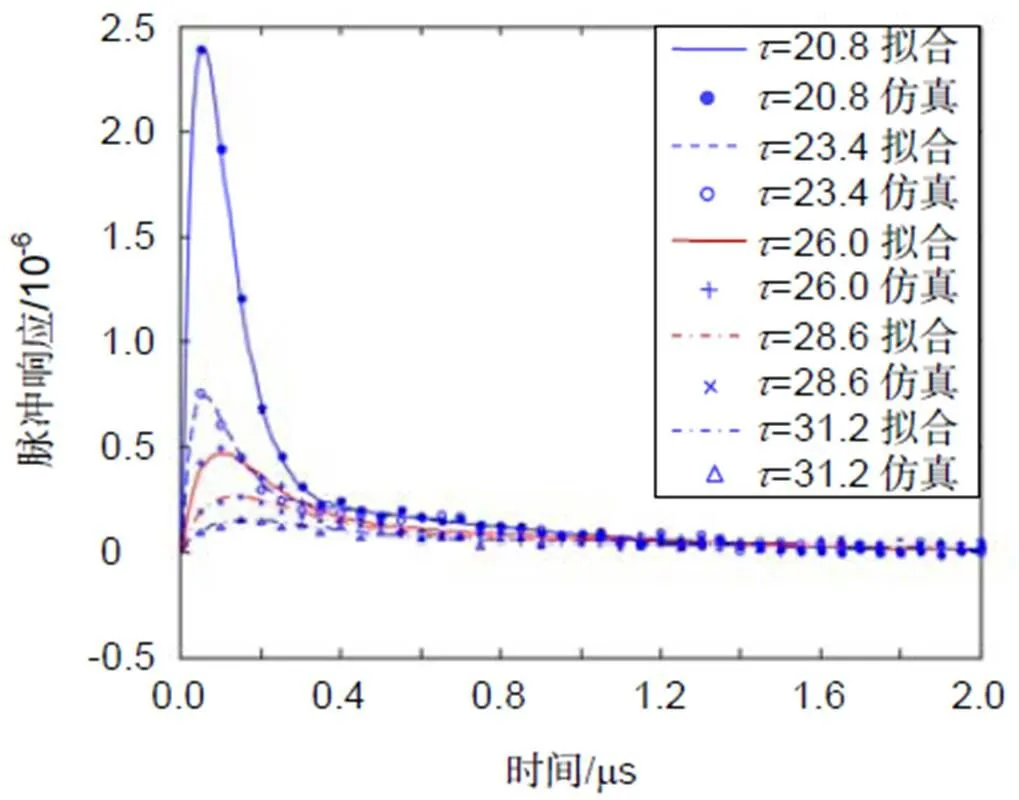
图5 脉冲响应拟合曲线
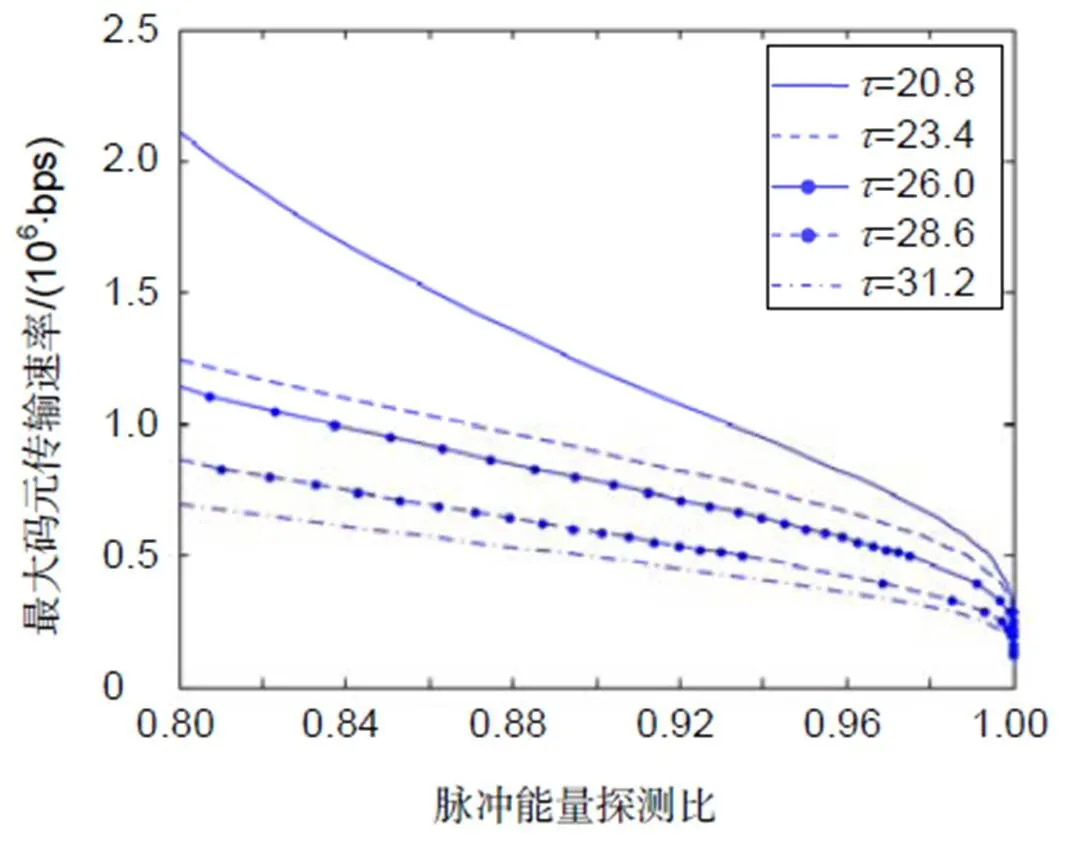
图6 脉冲能量探测比与最大码元传输速率
6 云层厚度对误码率的影响
在通信速率小于最大传输速率时,由时间扩展引起的码间串扰并不会影响性能,误码率主要受湍流造成的光强闪烁和接收器噪声影响;而当通信速率超过最大传输速率,码间串扰则成为主要因素,其波形示意图如图8。
根据文献[18],采用OOK调制,且发送“1”与“0”概率相等时,系统的平均误码率为



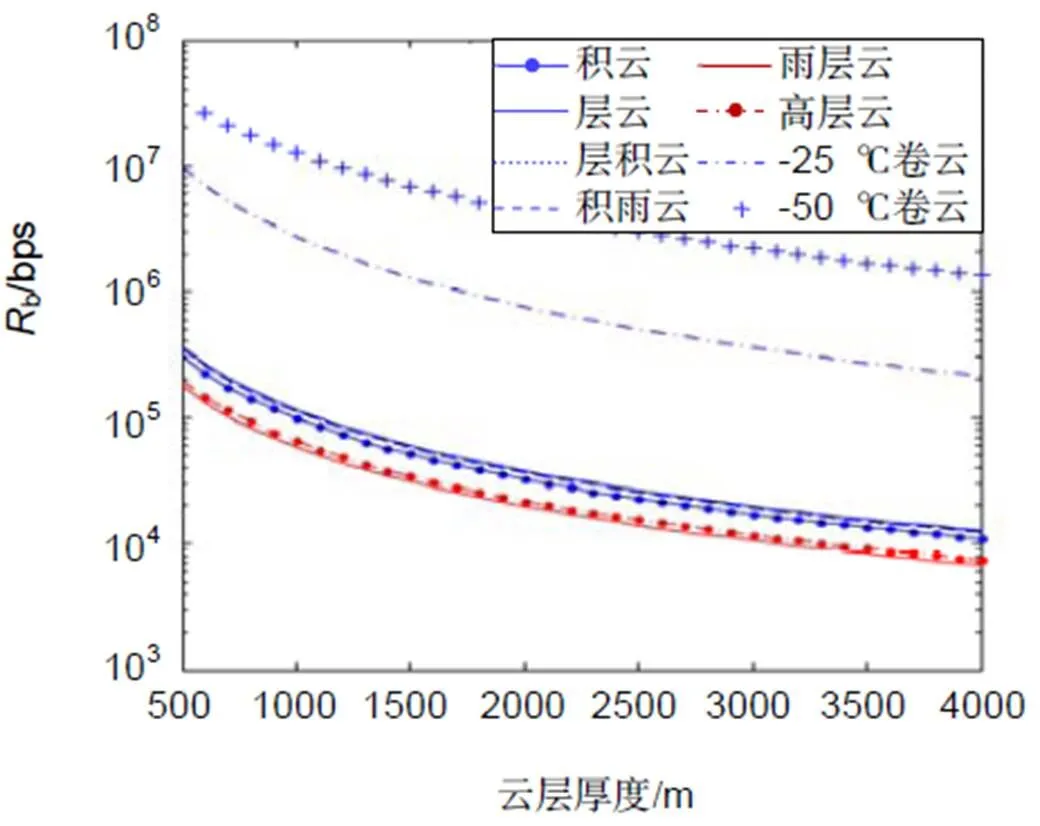
图7 云层厚度与最大码元传输速率



当传输速率为5 Mbps时,云层的光学厚度不同时,信噪比与误码率之间的关系如图9。

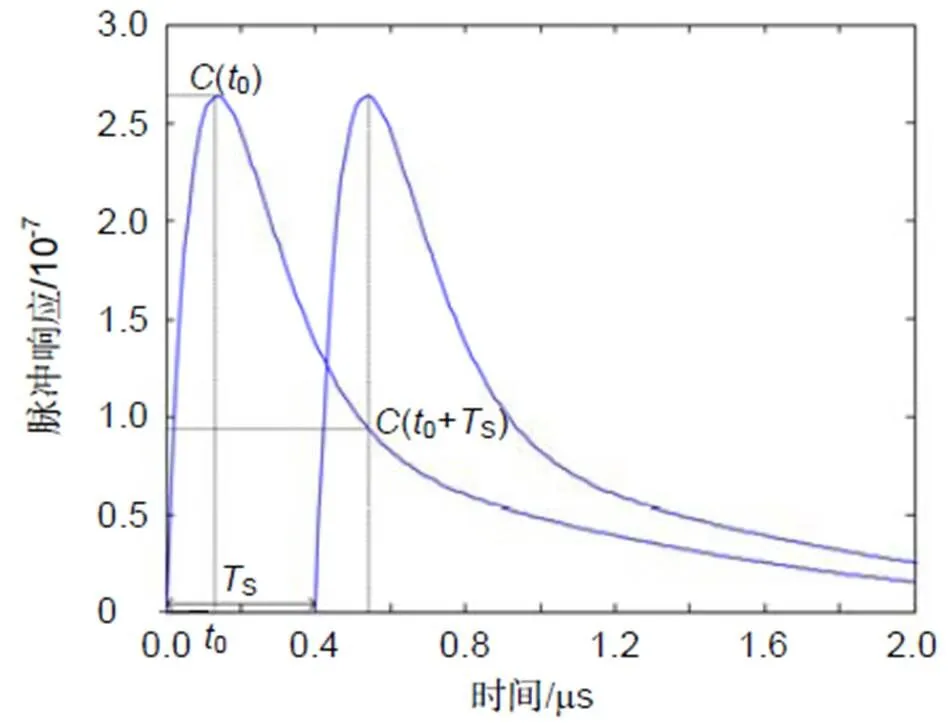
图8 码间串扰波形示意图
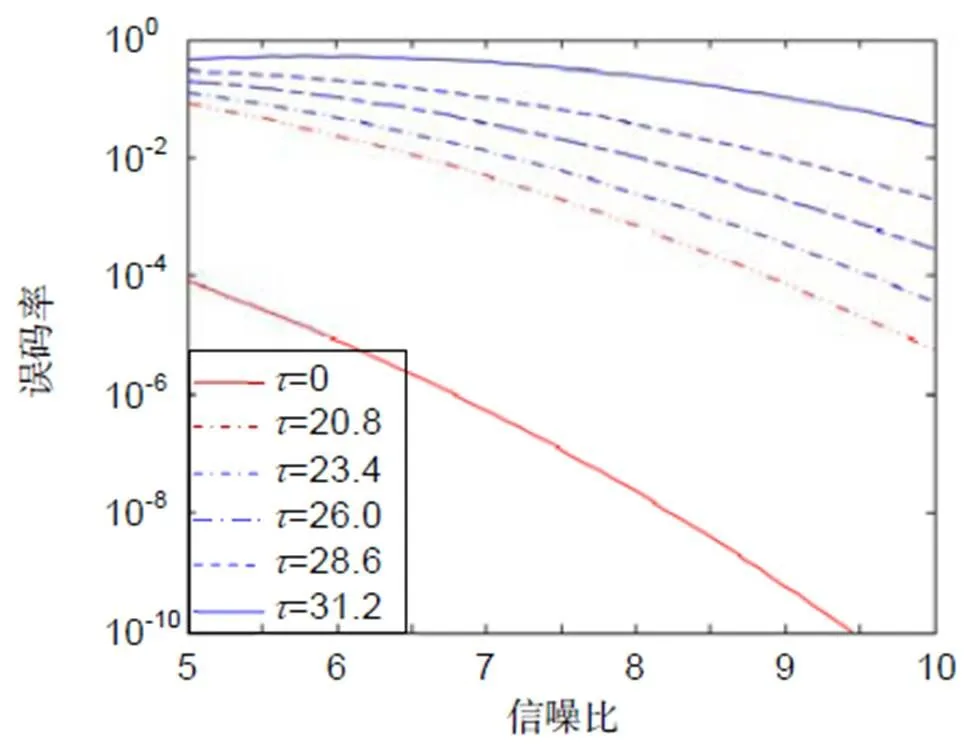
图9 信噪比与误码率
7 结束语
本文主要从能量衰减及时间扩展角度研究不同类型的云及云层厚度对蓝绿激光通信性能的影响。得到结论:云层主要影响链路余量、最大通信速率和误码率,对信噪比的影响很小。卷云对通信性能几乎无影响;积云对通信性能的影响次之;其次是层云、层积云和积雨云,且三种云的差异很小,可不作区分;高层云和雨层云对通信性能影响较大,其中雨层云的影响更大。
从链路余量角度看,云层的影响占主导地位,一方面云层影响了天气的阴晴,从而影响了云层下气溶胶的衰减系数,导致链路余量下降;另一方面云层的厚度也直接导致了激光能量的衰减,且影响较大。但对链路余量大于20 dB的系统来说,云的存在不会使通信中断。
从信噪比角度看,湍流的影响仍然占主导地位,云层厚度只是使通信性能略微降低。中湍流时信噪比在5.63 dB~5.68 dB之间,弱湍流时信噪比在6.74 dB~6.82 dB之间,与无云时基本一致。
从最大通信速率角度看,脉冲通过云层时由于多径效应造成时间扩展,当通信速率过大时会造成码间串扰,因此会限制最大通信速率。云层厚度4000 m时,雨层云与高层云的最大传输速率小于104bps,积云、层云、层积云和积雨云略大于104bps,-25 ℃卷云为2´105bps,-50 ℃卷云为1.3´106bps。
从误码率角度看,由于云层限制了最大通信速率,因此当通信速率超过最大值时会造成码间串扰,增加了误码率,造成通信质量下降。改善方法有发送端速率自适应和接收端信道均衡,有待于进一步研究。
[1] Bucher E A. Computer simulation of light pulse propagation for communication through thick clouds[J]., 1973, 12(10): 2391–2400.
[2] Mooradian G C, Geller M. Temporal and angular spreading of blue-green pulses in clouds[J]., 1982, 21(9): 1572–1577.
[3] Di L F, Wang P, Lu Y H,. Experiment and calculation of 532nm laser scattering in the near ground atmosphere[J]., 2005, 22(6): 960–964.
狄凌峰, 王沛, 鲁拥华, 等. 近地大气532 nm激光散射的实验与计算[J]. 量子电子学报, 2005, 22(6): 960–964.
[4] Hess M, Koepke P, Schult I. Optical properties of aerosols and clouds: The software package OPAC[J]., 1998, 79(5): 831–844.
[5] Hu X H, Zhou T H, Zhu X L,. Simulation of downward laser pulse propagation through clouds[J]., 2015, 36(2): 8–12.
胡秀寒, 周田华, 朱小磊, 等. 云对激光下行传输影响的仿真研究[J]. 红外, 2015, 36(2): 8–12.
[6] Arnon S, Sadot D, Kopeika N S. Analysis of optical pulse distortion through clouds for satellite to earth adaptive optical communication[J]., 1994, 41(8): 1591–1605.
[7] Arnon S, Kopeika N S. Adaptive optical transmitter and receiver for space communication through thin clouds[J]., 1997, 36(9): 1987–1993.
[8] Liu J B, Li H. Calculation of light scattering on water cloud particles by using Mie's theory[J].(), 2009, 34(6): 863–867.
刘建斌, 李海. 基于Mie理论的四种典型水云的光散射计算[J]. 广西大学学报(自然科学版), 2009, 34(6): 863–867.
[9] Chen C Y, Yang H M, Jiang H L,. Analysis of bit-error-rate and performance enhancement ways for optical communication link through cloud channel[J]., 2009, 21(5): 1245–1248.
陈纯毅, 杨华民, 姜会林, 等. 云层信道光通信链路误码率及性能改善途径分析[J]. 系统仿真学报, 2009, 21(5): 1245–1248.
[10] Ke X Z, Xi X L.[M]. Beijing: Beijing University of Posts and Telecommunications Press, 2004.
柯熙政, 席晓莉. 无线激光通信概论[M]. 北京: 北京邮电大学出版社, 2004.
[11] Yang H, Yang X L. Monte carlo simulation of light pulse propagation through clouds[J]., 2008, 29(2): 44–46.
杨虹, 杨小丽. 激光在云层信道中传输的蒙特卡罗模拟[J]. 激光杂志, 2008, 29(2): 44–46.
[12] Ke S Y. A thesis submitted in fully fulfillment of the requirement for the degree of master of engineering[D]. Wuhan: Huazhong University of Science and Technology, 2007.
柯善勇. 空间激光通信中的信道建模研究[D]. 武汉: 华中科技大学, 2007.
[13] Winker D M, Poole L R. Monte-Carlo calculations of cloud returns for ground-based and space-based LIDARS[J]., 1995, 60(4): 341–344.
[14] Li J Z.[M]. Xi’an: Shaanxi Science and Technology Press, 1986: 859–862.
李景镇. 光学手册[M]. 西安: 陕西科学技术出版社, 1986: 859–862.
[15] Liu M, Liu X G, Mou J Y,. Analysis of power attenuation model for wireless optical communication[J]., 2012, 41(8): 2136–2140.
刘敏, 刘锡国, 牟京燕, 等. 无线光通信光功率衰减模型分析[J]. 红外与激光工程, 2012, 41(8): 2136–2140.
[16] Li Y Q, Zhu Y, Wang J P.Principle and technology of optical communication[M]. Beijing: Science Press, 2006: 321–323.
李玉权, 朱勇, 王江平. 光通信原理与技术[M]. 北京: 科学出版社, 2006: 321–323.
[17] Stotts L B. Closed form expression for optical pulse broadening in multiple-scattering media[J]., 1978, 17(4): 504–505.
[18] Lee S, Hamzeh B, Kavehrad M. Airborne laser communications and performance enhancement by equalization[C]//. San Jose, California, United States: SPIE, 2006.
Analysis of the effect of cloud thickness on the performance of blue-green laser communication
Li Songlang*, Mao Zhongyang, Liu Chuanhui, Liu Min
Naval Aviation University, Yantai, Shandong 264001, China
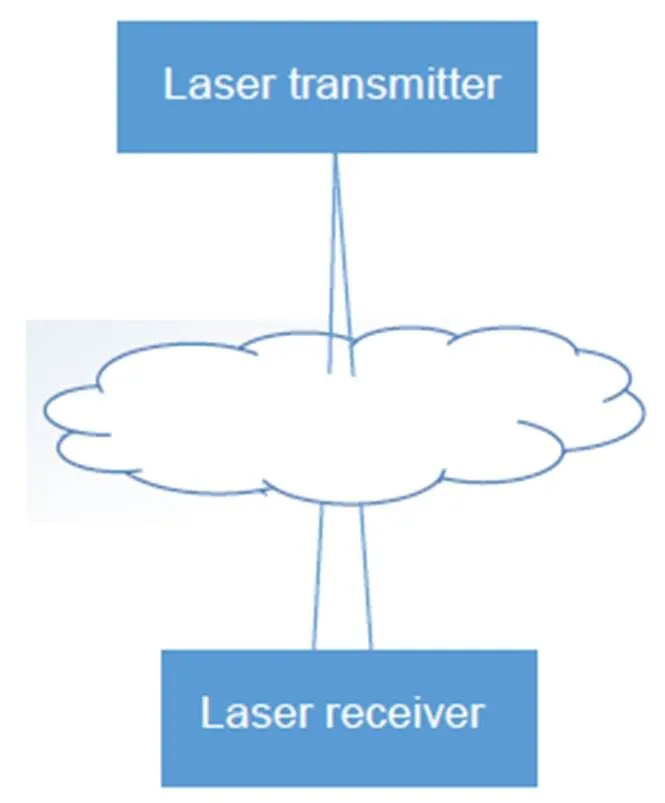
Schematic of laser passing through clouds
Overview:Using airborne wireless optical communication, if the laser transmitter located above or in the center of the cloud, the quality of communication on the receiving end will be severely degraded. Therefore, effective measures should be taken to improve communication performance. It is necessary to analyze the influence of clouds on the performance of wireless optical communication, which provides a theoretical basis for the rate adaptation and channel equalization design when there are clouds on the link.
In this paper, Vande Hulst formula is used to simulate the transmittance of blue-green laser passing through clouds, and calculate link margin and SNR. The monte carlo simulation method is used to simulate the waveform of the pulse passing through the thin clouds, and the waveform is fitted as a double gamma function. The relationship between the detection ratio of simulated pulse energy and the maximum symbol transmission rate is simulated. Stotts formula is used to calculate the time width of half power point, then estimate the maximum symbol transmission rate, and calculate the bit error rate in excess of maximum transmission rate.
It is concluded that cloud mainly causes laser energy attenuation, which affects maximum communication rate and bit error rate, but has little effect on SNR. Cirrus has little effect on communication performance, stratus, stratocumulus, and cumulonimbus have a great influence on the communication performance, but the differences between the three types of clouds are small and could be not be distinguished. Altostratus cloud and nimbostratus have great influence on communication performance, of which nimbostratus has greater influence than altostratus cloud.
From the perspective of laser energy attenuation, cloud plays a dominant role. For communication systems with link margin greater than 18.9 dB, 4 km cloud cover is allowed on the link. From the point of view of SNR, the influence of turbulence is still dominant, and the cloud thickness only reduces the SNR slightly, which is basically the same as that without cloud. From the perspective of maximum communication rate and bit error rate, the time expansion will be caused due to multi-path effect when the pulse passes through the cloud. The inter-symbol crosstalk will be caused when the communication rate is too high, so the communication rate will be limited. When the communication rate exceeds the maximum value, it will cause inter-code crosstalk, increase the bit error rate, and reduce the communication quality. The improved methods include the sending end rate adaptive and the receiving end channel equalization, which need to be further studied.
Citation: Li S L, Mao Z Y, Liu C H,Analysis of the effect of cloud thickness on the performance of blue-green laser communication[J]., 2020, 47(3): 190389
Analysis of the effect of cloud thickness on the performance of blue-green laser communication
Li Songlang*, Mao Zhongyang, Liu Chuanhui, Liu Min
Naval Aviation University, Yantai, Shandong 264001, China
When the airborne laser transmitter is located above or in the center of the cloud, the cloud will reduce the laser communication performance. In order to solve this problem, the effects of different types of clouds on laser energy attenuation, signal-to-noise ratio (SNR), maximum symbol transmission rate and bit error rate are simulated and analyzed. It is concluded that the cloud mainly causes laser energy attenuation, which affects maximum transmission rate and bit error rate, but has little effect on SNR. For communication systems with link margin greater than 18.9 dB, 4 km cloud cover is allowed on the link. The effect of cloud on the maximum communication rate and bit error rate is mainly caused by inter-symbol crosstalk caused by time extension. Cirrus has little effect on communication performance, cumulus has a great impact on communication performance, and stratus, stratocumulus, and cumulonimbus have a greater influence on the communication performance, but the differences between the three types of clouds are small and could be not be distinguished. Altostratus cloud and nimbostratus have greatest influence on communication performance, of which nimbostratus has greater influence than altostratus cloud.
optical wireless communication; atmospheric channel; optical thickness; cloud thickness; blue-green laser communication
TN929.12
A
10.12086/oee.2020.190389
: Li S L, Mao Z Y, Liu C H,. Analysis of the effect of cloud thickness on the performance of blue-green laser communication[J]., 2020,47(3): 190389
2019-07-08;
2019-10-21基金项目:国家自然科学基金资助项目(6170012154);山东省“泰山学者”建设工程专项经费基金资助项目(ts20081130)
李松朗(1995-),女,硕士研究生,主要从事蓝绿激光通信的研究。E-mail:772591662@qq.com
李松朗,毛忠阳,刘传辉,等. 云层厚度对蓝绿激光通信性能的影响分析[J]. 光电工程,2020,47(3): 190389
Supported by National Natural Science Foundation of China (6170012154) and Shandong Province "Taishan Scholars" Construction Project Special Funds (ts20081130)
* E-mail: 772591662@qq.com

